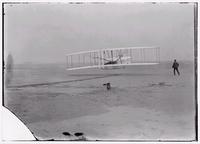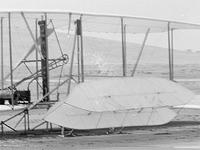The media is focusing more and more on the upcoming 100th anniversary of powered flight. In case you’ve been living in a hermetically sealed bubble, that date is December 17, 2003. That’ll mark one hundred years since the Wright Brothers achieved powered flight on the windswept expanse of North Carolina’s Outer Banks with an aircraft that I still can’t believe actually got into the air.
Here’s one such article from CNN.
 The more I learn about the 1903 Wright Flyer, the more I think luck was a massive element in the Wilbur and Orville’s success. So I’m a little curious to see if the key event in the centennial celebration–a recreation of that first flight–will succeed.
The more I learn about the 1903 Wright Flyer, the more I think luck was a massive element in the Wilbur and Orville’s success. So I’m a little curious to see if the key event in the centennial celebration–a recreation of that first flight–will succeed.
Obviously, the original Wright Flyer is too old and valuable to pull out of the National Air & Space Museum for a flight. So a replica was built by Ken Hyde at The Wright Experience. The goal is to fly this thing on December 17th at the exact moment when the Wright’s made their first flight.
When I say an exact replica, I mean exact. Hyde went so far as to use the exact same fabrication techniques the Wright’s employed. And doing that was not easy. The original Flyer was covered in a material which is not made anymore. And the Wright brothers destroyed all their construction notes and plans because they were in the process of patenting three-axis flight control and didn’t want any of their work to end up in the hands of competitors. So Hyde has been forced to reverse engineer much of the technology and answer questions about the engine and airframe that we really aren’t sure about even today.
Anyway, the Wrights did have some flight experience when they made the first powered flight. They had constructed and flown a series of gliders and kites between 1899 and 1903. These helped them validate their theories and find avenues for improvement in the aircraft design.
Today’s Wright Flyer pilots are training for the Big Day as well. In fact, the replica made its first flight today.
Still, I wonder about luck. There’s no doubting that the Wright brothers were experimenters and scientists of the first order. A lot of skill and research went into their work. But I mean, what if it’s raining at 10:35 a.m. on December 17th? Will the aircraft fly in the rain? Will they even attempt it?
What if the notorious winds of the Outer Banks gust and blow at 50 mph? What if there’s no wind at all? The Wright’s traveled to North Carolina from their home in Dayton, Ohio specifically because of that wind. They needed it to get the Flyer airborne by the time it came off the launch rail.
Sure, the Wrights were successful. Eventually. But many people don’t know that they broke many aircraft and even injured themselves on occasion before making that first flight. So what will happen when modern pilots try to fly this oddball aircraft?
The Wright Flyer was not an easy aircraft to control. For one thing, the cruise speed and stall speeds were very close together. In modern aviation parlance, this is called a “coffin corner”. Not good. Also, the Flyer had a very odd control system. It didn’t employ modern control surfaces like ailerons. Instead the Wright’s invented method of physically warping the wings. This changed their camber and therefore the amount of lift they provided. The pilot actuated this by sliding his hips as he laid down on top of the lower wing. (see how it worked)
The Flyer also had a CG (center of gravity) problem. And then there’s the engine. It had no throttle. It was either on or it was off. And it had no landing gear to speak of, just a set of wooden skids which could easily dig into the grass and nose the aircraft over. Now add in some wind and the fact that neither brother had ever flown this thing before and you can see what they were up against.
The pilots who will fly the replica on December 17th are being trained by Scott Crossfield, one of the most famous and highly respected former test pilots alive. If the weather cooperates, they have a good chance of success. But make no mistake about it, that plane is a tough customer even under the best of circumstances. This event could easily end with someone getting hurt.
 In fact, the original Wright Flyer was actually destroyed on December 17, 1903–the same day it made its first flight! The brothers made their four famous flights, and on the fifth attempt that day Wilbur nosed the plane into the ground, breaking off the canard. They tried to carry the machine back to their shed, but the wind was so strong it overturned the plane and smashed it into pieces. The broken plane never flew again.
In fact, the original Wright Flyer was actually destroyed on December 17, 1903–the same day it made its first flight! The brothers made their four famous flights, and on the fifth attempt that day Wilbur nosed the plane into the ground, breaking off the canard. They tried to carry the machine back to their shed, but the wind was so strong it overturned the plane and smashed it into pieces. The broken plane never flew again.
In some ways, the flight of the replica seems far more hazardous than the flight of the original. The Wright brothers flew on December 17th because the conditions were right for them to make an attempt. The replica is going to fly on December 17th because that’s the anniversary. If the conditions are poor, the 2003 flight may be attempted in conditions the Wright brothers would have rejected 100 years earlier.
So there you have it. Recreating history authentically, right down to the risk to life and limb. I hope Lady Luck smiles on December 17th, just for old time’s sake.

I can’t wait to see how it turns out!